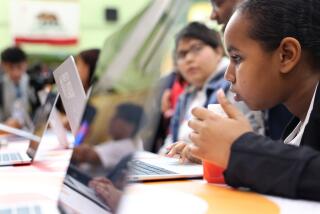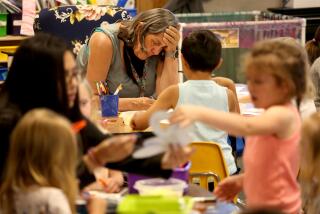MISSION VIEJO : Educators Applaud Computers as Aides
- Share via
Teachers at the Saddleback Unified School District no longer need to rely on cardboard pictures of Spot the Dog. Instead, with the push of a button, a nearly perfect image of a Renoir Pekingese appears on a television screen.
In chemistry classes, dreary charts are accompanied by video images of chemicals bubbling in test tubes. And in English-as-a-second-language classes, foreign-born students are using a computer reproduction of their own faces and voices to learn the English word for each facial feature.
The technological advancements are part of the district’s yearlong experiment with “hypercard,” a computer-linked media system. Teachers enter text and graphics into the computer, while at the same time programming slides and video images to pop on and off from an adjacent screen.
For instance, using a National Museum of Art videodisc, teachers can retrieve Vincent van Gogh’s “Farmhouse in Provence” in three seconds, and with the punch of another button, reveal a videotape lecture on the same painting. Meanwhile, the computer grinds out questions and information on Van Gogh’s life.
Hypercard “opens the ability to broaden lesson plans. Teachers are using the computer to renew themselves and avoid burnout,” said Linda Smith, the district’s educational-technology specialist who heads the hypercard program.
The $100,000 program was started last year at 32 of the district’s schools. This year, at least one hypercard module will be installed at every school in the district and more computers will be added with a $125,000 grant from IBM. Nine additional computers also will be added for student programming classes.
According to teachers who used hypercard last year, the computer system revolutionized their teaching methods.
“It would take four to five hours to prepare the same lesson without the hypercard,” said Debbie Derloshom, a fourth-grade teacher at La Madera Elementary.
In her program on California missions, Derloshom used computer-drawn Indians and music from “The Twilight Zone” to appeal to her Nintendo-generation students. She also wrote her own text for the program, one that she thought was more challenging than that contained in the students’ textbook.
“I tried to include both the pros and cons of Father Junipero Serra, from both the Indians’ and the Spanish point of view . . . things that are not in the fourth-grade textbook.”
Some of the other programs invented by teachers last year included one containing the text of the original “Cinderella” story spliced with the animated Disney tale running on the videodisc player, and a program on rocks and minerals that analyzed specimens that students brought from their back yards.
The hypercard programs were a big success with her students, Derloshom said, because each child took a turn operating the computer.
“I saw problem kids become leaders. Those kids tend to take risks and with the computer, if you take risks, you succeed,” Derloshom said.
The district also plans to use hypercard public relations programs for prospective residents at the district headquarters and at the Rancho Santa Margarita home-buyers center.
But the emphasis will continue to be on using hypercard as a classroom tool, Smith said. While only 32 teachers--one at each of the equipped schools--took advantage of the program last year, about 36 are expected to participate this year and many schools are investing in additional computers so that the technology will be available to more than one class.
“It takes hundreds of hours to learn how to use (hypercard) and implement it, but once you have it, it opens up a whole new world,” Smith said.
More to Read
Sign up for Essential California
The most important California stories and recommendations in your inbox every morning.
You may occasionally receive promotional content from the Los Angeles Times.









